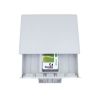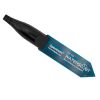Spectrum WatchDog 1000 Series Irrigation Stations
Features
- Save when purchasing as an Irrigation Station
- Includes WatchDog Station and WaterScout Sensors with 20 ft. cables
- Stations include the protective sliding enclosure
- Free ground shipping
- Expedited repair and warranty service
- Lifetime technical support
- More
Overview
The Spectrum WatchDog 1000 Series Irrigation Stations are a cost-effective choice for recording environmental conditions over a period of time. Whether it's weather or soil moisture monitoring, the WatchDog 1000 Series Micro Station will deliver timely, accurate data. The LCD display confirms station operation and provides current sensor readings. The stations are customizable with up to four unique external plug-in sensors. Change monitoring parameters from one season to the next, simply by connecting a different sensor. Options include a water resistant Sliding Enclosure and a Waterproof Enclosure to protect the Micro Station from the elements.
Benefits
- Internal sensors can include temperature and humidity
- With up to 4 external sensor ports, you choose the sensors you need
- LCD displays current sensor readings and battery level
- Select measurement intervals from 1 to 60 minutes
- Log 10,584 intervals (220 days at 30-minute intervals), 8,064 intervals with virtual channels enabled (for SMEC 300)
- Data is stored in fail-safe non-volatile memory
- Water-resistant case
- 12-month battery life (CR2450, included)
- Transfer data with a direct-connect cable or Data Shuttle
- Requires SpecWare 9 Basic or Pro software
In The News
Spring 2025 Environmental Monitor Available Now
In the Spring 2025 edition of the Environmental Monitor, we highlight partnerships across the world and the importance of collaboration between government agencies, universities, environmental groups, local communities, and other stakeholders. From great white shark research in Cape Cod to monitoring fisheries in Lake Erie, this latest edition underscores partnerships that connect stakeholders in a watershed through environmental data. With an emphasis on data sharing, a combination of real-time and discrete sampling keeps the public and partners informed of environmental conditions. Our writers also sought out science professionals dedicated to working with peers within and outside of the environmental sector.
Read MoreMonitoring Mariculture in the Gulf of Alaska
The mariculture industry in the Gulf of Alaska has been steadily growing in recent years, guided by ongoing research to help refine farm location and cultivation practices. A subset of aquaculture, mariculture focuses on rearing organisms in the open ocean. In Alaska, finfish farming is illegal, so most farms cultivate kelp, oysters, or a combination of the two. These small, locally operated farms started popping up in the Gulf of Alaska in the early 1990s, when shellfish farming first became legal. Kelp farming did not begin to catch on in the state until 2016. Many of the coastal areas that have grown interested in mariculture are historically commercial fishing communities.
Read MoreSupplying Seattle’s Drinking Water: Using Data Buoys to Monitor the Cedar River Municipal Watershed
Providing clean, safe, and reliable drinking water for the 1.6 million people in the greater Seattle area is a top priority for Seattle Public Utilities (SPU). With limited water supplies, SPU dedicates considerable resources to maintain its watersheds and mountain reservoirs. About 70 percent of Seattle Water comes from the Cedar River Municipal Watershed , and the other 30 percent comes from the South Fork Tolt River Watershed . [caption id="attachment_39574" align="alignnone" width="940"] Data buoy in Chester Morse Lake . (Credit: Kevin Johnson / Seattle Public Utilities) [/caption] Jamie Thompson, a fisheries biologist at SPU, monitors aquatic ecosystems centered on fish listed under the U.S. Endangered Species Act (ESA).
Read More
























